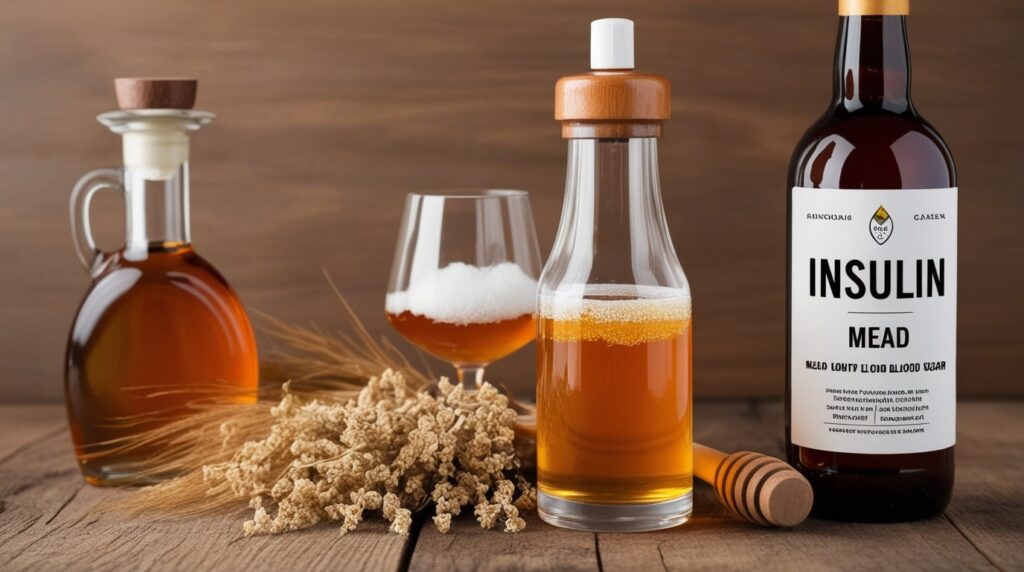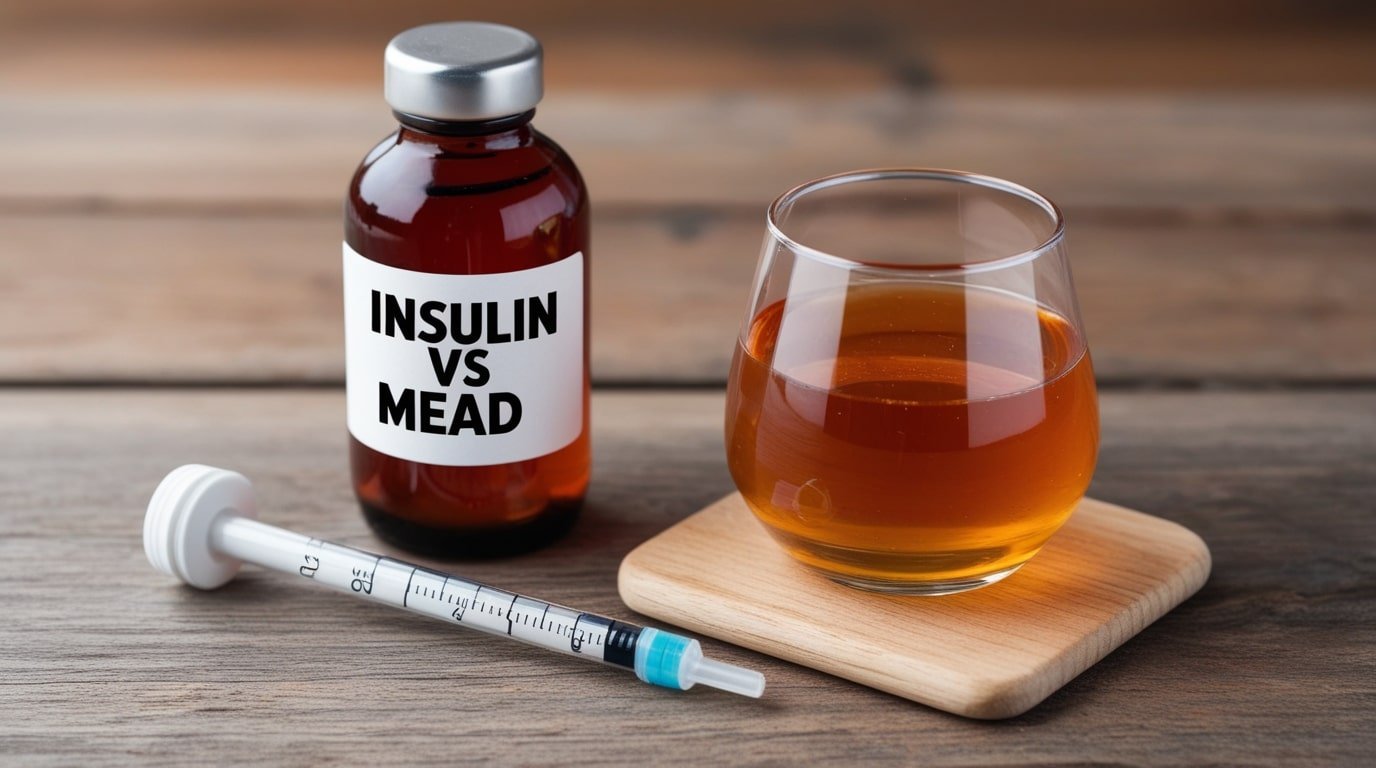When it comes to insulin and mead, there is a sharp contrast between the two. Insulin is a hormone essential for controlling blood sugar, while mead is an ancient honey-based alcoholic beverage. But why would someone want to compare these two? The comparison becomes relevant when you consider the impact of mead on blood sugar, especially for people who rely on insulin to manage their health.

Here w will explore how insulin functions, what mead is, and how consuming mead might affect your blood sugar. If you’re looking to understand whether mead is safe to drink for people with blood sugar concerns, and how it compares to insulin, you’re in the right place. Let’s dive in! 😊
What Is Mead? 🍯
Mead is an alcoholic drink made by fermenting honey with water, and sometimes other ingredients like fruits or spices. It’s one of the oldest alcoholic beverages, dating back thousands of years. Though mead is delicious and varied, it contains a significant amount of sugar, which is important to consider if you’re monitoring your blood sugar levels.
Comparison of Mead Types: Sugar Content, Flavor, and Best Uses
This table provides clear, digestible information on different types of mead, focusing on factors like sugar content, flavor profile, and ideal use. It’s concise and uses structured data, making it likely to appear as a rich snippet in search results, especially for queries related to “types of mead” or “mead sugar content.”
| Mead Type | Sugar Content | Flavor Profile | Ideal For |
|---|---|---|---|
| Dry Mead | Low | Crisp, less sweet | Health-conscious drinkers, lower sugar impact |
| Sweet Mead | High | Rich, dessert-like | Dessert pairing, indulgence |
| Semi-Sweet Mead | Moderate | Balanced sweetness | Occasional drinking, versatile |
| Sparkling Mead | Varies (low-high) | Fizzy, light | Celebrations, refreshing |
| Melomel | Varies (depends on fruit) | Fruity, sweet or tart | Fruit lovers, summer drinks |
| Metheglin | Varies (low-high) | Spiced, herbal | Holiday drinks, winter warmer |
| Cyser | Moderate | Apple, crisp and sweet | Autumn drinks, cider alternative |
| Bochet | Moderate | Caramelized, toffee-like | Rich flavor, dessert pairing |
Types of Mead: A Closer Look with Examples 🍯
Mead comes in a variety of styles, and the type of mead depends largely on its sweetness and the ingredients used. Let’s explore the main categories of mead, along with examples of each type to give you a clearer idea of what makes them unique.
1. Dry Mead
Dry mead contains little to no residual sugar, as most of the honey used in fermentation has been converted into alcohol. It has a crisp, less sweet flavor and can be compared to dry white wines in terms of taste. Dry meads are generally preferred by those looking for a lower-sugar option.
Examples of Dry Mead:
- Monks Meadery Dry Mead: A light-bodied mead with a crisp finish, perfect for those who enjoy a dry, refreshing beverage.
- Mountain Honey Wines – Traditional Dry Mead: This mead emphasizes the honey flavor without the sweetness, offering a clean and smooth taste.
2. Sweet Mead
Sweet mead contains more residual sugar because the fermentation process leaves more of the honey’s natural sugars intact. This makes the mead richer and more dessert-like in flavor, often with a higher calorie and carb content. Sweet meads are a popular choice for people who enjoy rich, sugary beverages.
Examples of Sweet Mead:
- Chaucer’s Mead: A classic example of a sweet mead, it’s made with a blend of honey and is often enjoyed as a dessert beverage.
- Redstone Meadery Traditional Sweet Mead: Rich in flavor and sweetness, this mead is perfect for those who like a heavier, more indulgent drink.
3. Semi-Sweet Mead
Semi-sweet meads strike a balance between dry and sweet. They contain some residual sugar but are not as heavy as sweet meads. These meads appeal to those looking for a moderate level of sweetness without it being overpowering.
Examples of Semi-Sweet Mead:
- Sky River Semi-Sweet Mead: Lightly sweet with floral honey notes, this mead is a perfect middle ground for those who want some sweetness but not too much.
- Moonlight Meadery – Desire: A semi-sweet mead blended with black cherries, blueberries, and black currants, offering a fruity and balanced flavor.
4. Sparkling Mead
Sparkling meads are carbonated, adding bubbles to the traditional mead experience. These meads can be dry, sweet, or semi-sweet and are often enjoyed chilled, like a sparkling wine or champagne.
Examples of Sparkling Mead:
- Enlightenment Wines – sparkling mead: A refreshing and bubbly take on mead, perfect for celebrations or as an alternative to sparkling wine.
- Heidrun Meadery Sparkling Mead: Naturally carbonated and crafted using the Champagne method, this mead offers a sophisticated and fizzy experience.
5. Melomel
Melomel is a type of mead made by fermenting honey with fruit. The added fruits can range from berries to stone fruits, which introduce new layers of flavor and complexity. Melomels can be dry, semi-sweet, or sweet depending on the amount of residual sugar left after fermentation.
Examples of Melomel:
- Black Raspberry Nectar Mead: A melomel made with black raspberries, resulting in a fruit-forward, sweet drink that pairs well with desserts.
- Dragon’s Breath Mead: Made with honey and blueberries, this melomel offers a rich, deep flavor with a blend of sweetness and tartness.
6. Metheglin
Metheglin is a spiced mead, made by adding spices or herbs during fermentation. Traditional spices used in metheglin include cinnamon, cloves, nutmeg, or ginger. This type of mead can be sweet, semi-sweet, or dry, depending on the recipe.
Examples of Metheglin:
- Moonlight Meadery – Wicked: A cinnamon-spiced mead that delivers warmth and spice, perfect for winter or holiday gatherings.
- Viking Blod Mead: A Danish mead with hibiscus and hops, offering a unique combination of sweet, spicy, and floral notes.
7. Cyser
Cyser is a hybrid mead made by fermenting honey and apple juice together, essentially combining the elements of mead and cider. The apple adds a refreshing fruitiness to the drink, while the honey provides a sweet balance.
Examples of Cyser:
- Avalon Mead’s Cyser: A semi-sweet blend of honey and apples, with a rich flavor profile.
- Earle Estates Meadery Apple Cyser: A perfect balance of tart apple and sweet honey, offering a crisp and refreshing taste.
8. Bochet
Bochet is a mead made from caramelized honey, giving it a deep, rich flavor with hints of toffee or burnt sugar. It’s a unique type of mead that has a darker color and a more intense taste than traditional meads.
Examples of Bochet:
- B. Nektar Meadery – Caramelized Bochet: A bold mead with notes of caramel, toffee, and roasted honey flavors.
- Aesir Meadery Bochet: A smooth, dark mead with deep, caramelized flavors that pairs well with robust dishes or desserts.
Insulin vs Mead: How Do They Affect Blood Sugar? ⚖️
When comparing insulin and mead, we’re really looking at how each affects your blood sugar. Insulin helps lower blood sugar, whereas consuming mead—especially sweet mead—can cause your blood sugar to spike due to its high sugar content.
Impact of Insulin on Blood Sugar
- Insulin lowers blood sugar by allowing cells to absorb glucose from the bloodstream.
- People with diabetes take insulin to manage blood sugar, preventing spikes and crashes.
Impact of Mead on Blood Sugar
- Mead, especially sweet mead, contains high levels of sugar, which can lead to increased blood sugar after consumption.
- Dry mead has less sugar but still contains alcohol, which can cause fluctuations in blood glucose levels.
For people who take insulin, consuming mead can be tricky. Alcohol can cause blood sugar to drop later, but the sugar content in mead can spike blood sugar immediately after consumption. This makes balancing insulin doses with alcohol consumption a complex task for people with diabetes.
Nutritional Comparison: Insulin vs Mead 📊
Although insulin isn’t a “food” with calories, it directly influences how the body processes sugar and carbohydrates. Mead, on the other hand, contains calories, sugar, and alcohol—all of which impact how the body metabolizes food and maintains blood sugar balance.
| Comparison | Insulin | Mead |
|---|---|---|
| Role | Lowers blood sugar | May spike blood sugar (especially sweet mead) |
| Calories | None | 300-400 calories (per 12 oz serving) |
| Carbohydrates | None | 35-50g carbs |
| Alcohol By Volume (ABV) | N/A | 8-20% ABV |
| Effect on Blood Sugar | Reduces blood sugar | May increase blood sugar levels |
Can People Who Need Insulin Drink Mead? 🩺
If you’re taking insulin or managing diabetes, you need to be cautious when drinking alcohol, including mead. The sugar content in sweet mead can cause an immediate rise in blood sugar levels, while the alcohol can lower blood sugar later on, leading to hypoglycemia (low blood sugar).
If you want to enjoy mead, it’s better to choose dry mead, which has less sugar, and monitor your blood sugar closely.
FAQs: Insulin and Mead ❓
Diabetics should be cautious with sweet mead because of its high sugar content. Dry mead might be a better option, but it’s important to monitor blood sugar levels closely.
If you take insulin, you need to carefully balance alcohol consumption with insulin dosages. Mead, especially the sweeter varieties, can cause spikes in blood sugar, followed by drops later due to the alcohol. Always consult your doctor before consuming alcohol if you’re taking insulin.
New treatments like GLP-1 receptor agonists and SGLT-2 inhibitors are used to help control blood sugar in people with type 2 diabetes. These medications work differently than insulin but help regulate glucose levels.
No, dextrose is a type of sugar, while insulin is the hormone that helps your body use sugar.
No, insulin is not classified as a narcotic. It is a hormone that helps manage blood sugar.
Insulin doesn’t have alternative names, but there are various types like rapid-acting insulin and long-acting insulin.
Conclusion: Insulin vs Mead 🍯💉
The comparison between insulin and mead is about understanding how they each impact blood sugar. Insulin lowers blood sugar and is essential for people with diabetes, while mead—especially sweet varieties—can raise blood sugar due to its high sugar content.
For people who take insulin, consuming alcohol like mead can be tricky and requires careful management to avoid blood sugar spikes or crashes. If you’re managing your blood sugar, it’s best to consult with your healthcare provider before incorporating mead or other alcoholic beverages into your diet.

